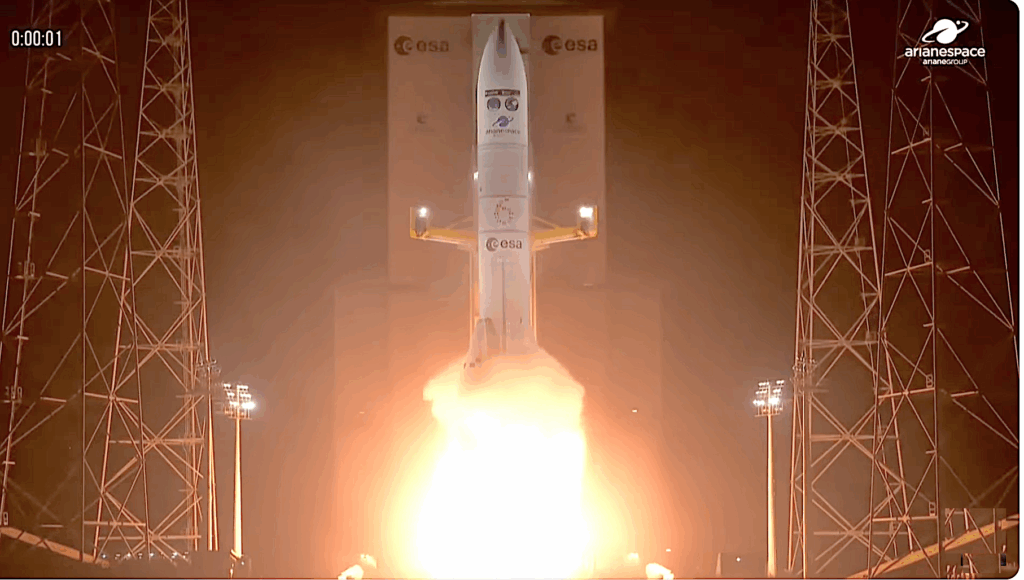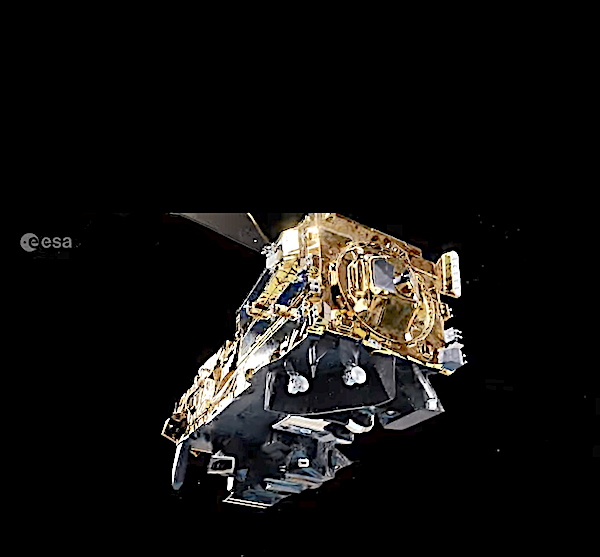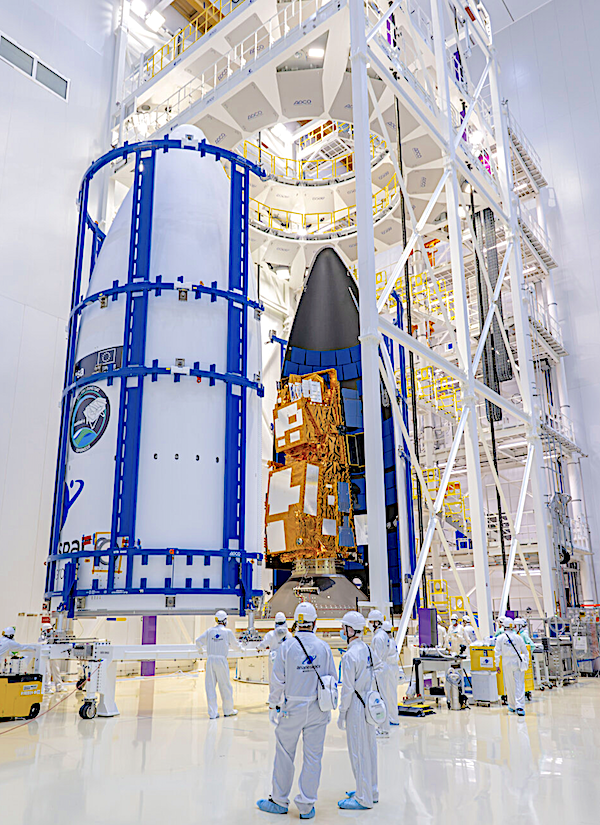
On August 12, 2025 at 9:37 p.m. local time in Kourou, French Guiana (00:37 a.m. UTC, 2:37 a.m. CEST, on August 13), Ariane 6 lifted off from Europe’s Spaceport carrying EUMETSAT’s Metop-SGA1 satellite.
With this second commercial flight, Ariane 6, the new European heavy-lift launcher operated by Arianespace, successfully placed Metop-SGA1 into Sun-synchronous orbit (SSO) at an altitude of 800 km. Spacecraft separation occurred 1 hour and 4 minutes after lift-off.
A few minutes after separation, EUMETSAT successfully acquired signals from the satellite.
David Cavaillolès, CEO of Arianespace, declared: “Tonight, Arianespace has successfully launched EUMETSAT’s Metop-SGA1 satellite, on board Ariane 6. The first of the next generation of European polar-orbiting weather satellites, Metop-SGA1 notably hosts the Copernicus programme Sentinel-5 atmospheric monitoring mission. This success pinpoints our dedication to ensuring Europe’s autonomous and reliable access to space while also supporting an ambitious environmental mission that will provide cutting-edge data for weather and climate monitoring. Ariane 6’s second commercial launch marks a significant milestone in our journey. We extend our gratitude to EUMETSAT and to all our partners across Europe for their trust and collaboration, driving Arianespace to deliver the utmost excellence.”
“The success of this second commercial launch confirms the performance, reliability, and precision of Ariane 6. Once again, the new European heavy-lift launcher meets Europe’s needs, ensuring sovereign access to space,” said Martin Sion, CEO of ArianeGroup. “The next rockets are well advanced in production thanks to the teams to whom I express my gratitude for their unwavering commitment. This demonstrates the ramp up taking place in ArianeGroup’s plants and those of our industrial partners.”
Phil Evans, Director-General of EUMETSAT, commented: “Extreme weather has cost Europe hundreds of billions of euros and tens of thousands of lives over the past 40 years—storms like Boris, Daniel and Hans, record heatwaves and fierce wildfires are just the latest reminders. The launch of Metop-SGA1 is a major step forward in giving national weather services in our member states sharper tools to save lives, protect property, and build resilience against the climate crisis. These positive impacts will be felt even beyond that and over the Atlantic, as Metop-SGA1 is Europe’s first contribution to the Joint Polar System with NOAA. This milestone reflects years of teamwork across EUMETSAT, ESA, the EU, CNES, DLR, Airbus, Thales Alenia Space, and many others. This is the beginning of an exciting new chapter as we work to ensure the satellite settles into orbit and starts delivering the vital data it was built to provide.”
For this second commercial mission, the Ariane 6 vehicle was in the two-booster Ariane 62 configuration with a short fairing.
Ariane 6 is a program developed within the framework of the European Space Agency (ESA). As prime contractor and design authority for the launcher, ArianeGroup is responsible for development and production alongside its industrial partners. Ariane 6 is marketed and operated by Arianespace.
The Metop-SGA1 (Second Generation A1) satellite will be the first of the next generation of European polar-orbiting weather satellites. Metop-SGA1 will host a total of six atmospheric sounding and imaging instrument missions that will provide optical, infrared, and microwave observations essential data for weather forecasting, climate monitoring, and a wide range of other services and applications. Amongst its hosts, Metop-SGA1 will carry the new Sentinel-5 atmospheric monitoring mission, part of the European Commission’s Copernicus programme. The spacecraft was built by Airbus Defence and Space, under a contract with the European Space Agency, and will be operated throughout its lifetime by EUMETSAT, that will also distribute its data to users.
The VA264 launch at a glance:
- 355th launch by Arianespace
- 3rd Ariane 6 launch and 2nd commercial flight
- 15th satellite launched by Arianespace for EUMETSAT
- 151st spacecraft built by Airbus Defence and Space launched by Arianespace
- 21st meteorological satellite launched by Arianespace
Arianespace ready for Tuesday launch of EUMETSAT’s Metop-SG A1 weather satellite

Europe’s first MetOp Second Generation, MetOp-SG-A1, weather satellite — which hosts Copernicus Sentinel-5 as part of its instrument package — is set for liftoff on an Ariane 6 rocket from Europe’s Spaceport in Kourou, French Guiana, on 13 August 2025 at 02:37 CEST (12 August 21:37 Kourou time).
First of EUMETSAT’s second generation of Metop weather satellites. Metop-SG A1 is the first satellite in the Metop Second Generation (Metop-SG) series, a joint project by the European Space Agency (ESA) and EUMETSAT. It will be launched in August 2025, alongside the Copernicus Sentinel-5 instrument, on an Ariane 6 rocket. Metop-SG A1 is designed to provide continuity of global observations for weather forecasting and climate analysis, offering enhanced data compared to the first generation of Metop satellites
The forecast calls for a temperature of 77°F, broken clouds, 54% cloud cover and a wind speed of 2mph.

Ariane Launch Area 4 has witnessed the launch of 2 rockets, including 2 orbital launch attempts. While Guiana Space Centre, French Guiana, has been the site for 326 rocket launches.
The Guiana Space Center is a European spaceport to the northwest of Kourou in French Guiana, a region of France in South America. Kourou is located at a latitude of 5°. In operation since 1968, it is a suitable location for a spaceport because of its equatorial location and open sea to the east. The Ariane 62, manufactured by ArianeGroup established in 2015, undertook its inaugural launch on 07/09/2024, is non-reusable and is active.
Ariane 62 has 2 successful launches and 0 failed attempts, with a cumulative tally of 2 launches, currently with 11 pending launches in the pipeline.
The Ariane 6 family is currently under development by the European Space Agency, with two variations including the Ariane 62 with two solid boosters intended for government and scientific missions.
